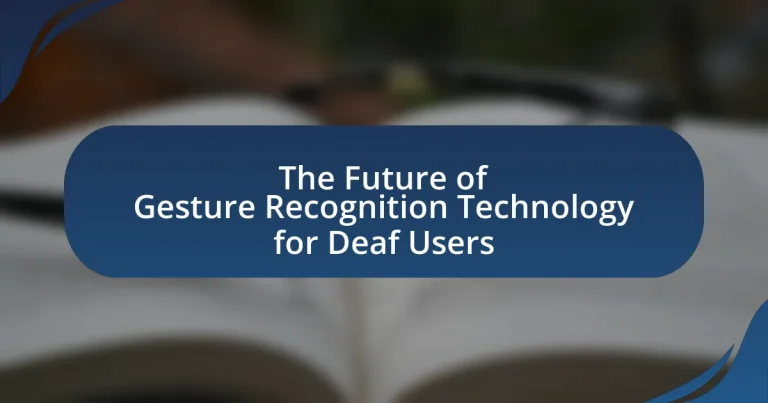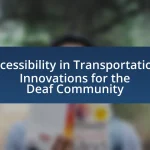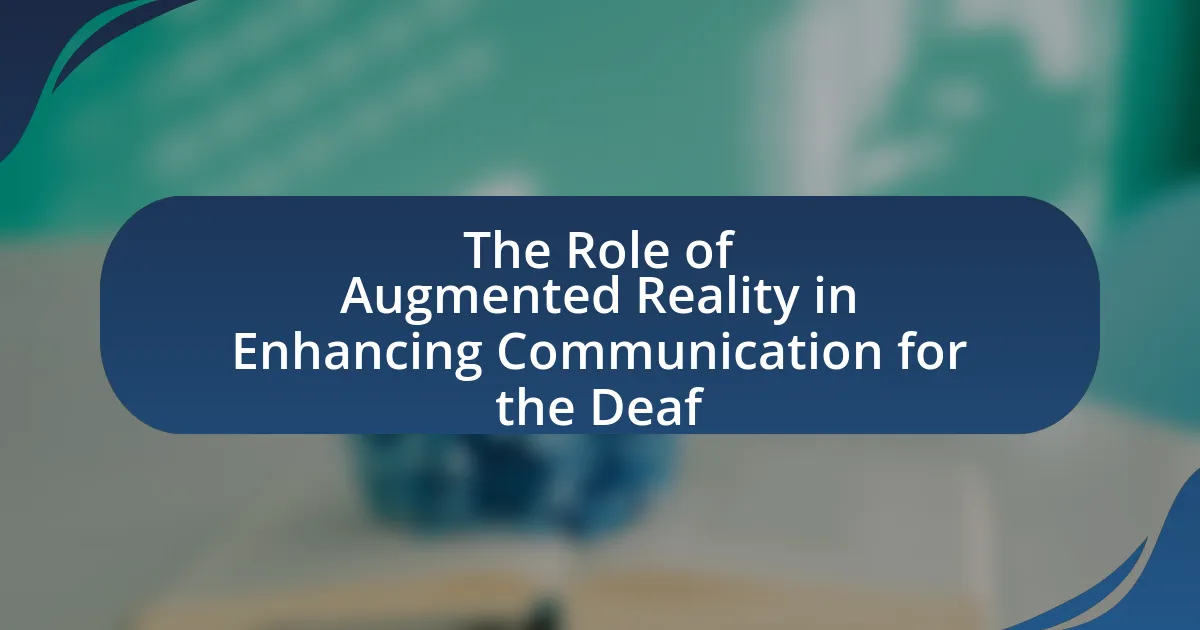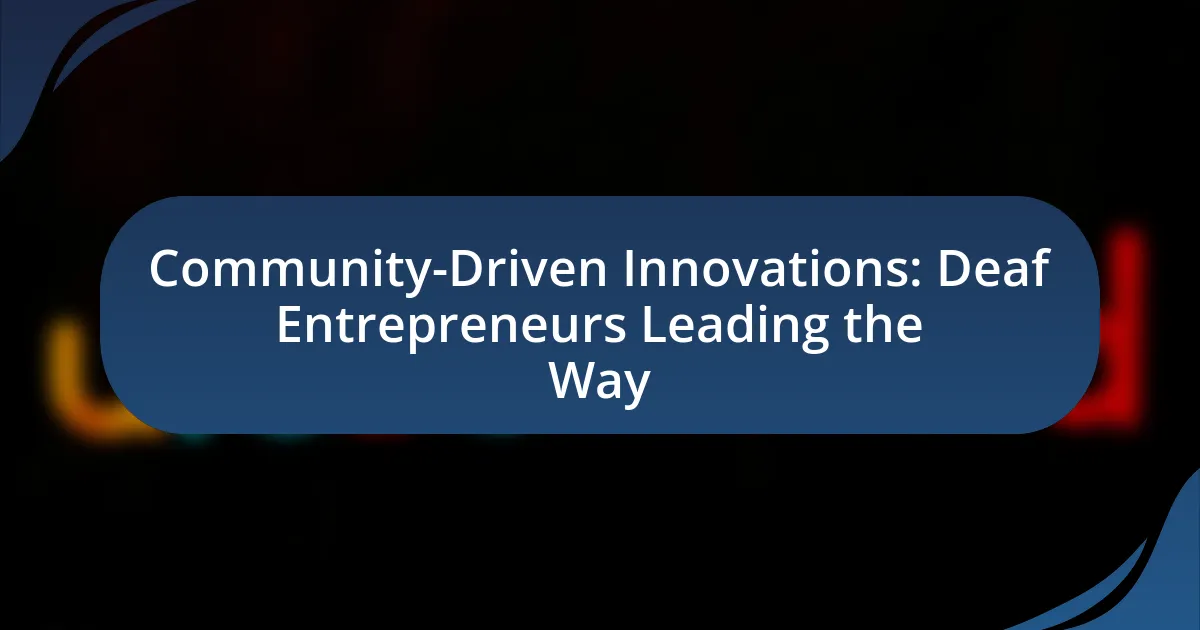Gesture recognition technology for deaf users is a system that interprets hand movements and gestures to facilitate communication for individuals who are deaf or hard of hearing. This technology employs sensors, cameras, and machine learning algorithms to translate gestures into text or speech, achieving high accuracy rates in recognizing sign language. The article explores the functioning of gesture recognition technology, key technologies involved, potential applications, and the impact of advancements in artificial intelligence and machine learning on improving accuracy. It also addresses challenges faced by current systems, the importance of inclusivity in design, and the future outlook for enhancing communication for deaf users through innovative solutions.
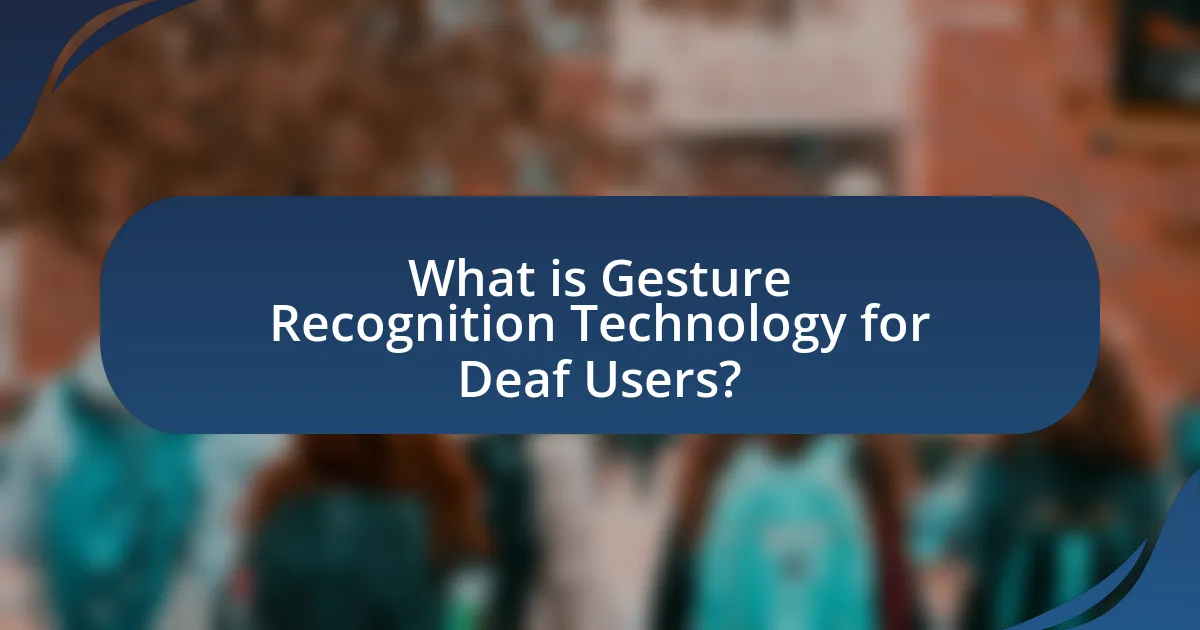
What is Gesture Recognition Technology for Deaf Users?
Gesture recognition technology for deaf users refers to systems that interpret hand movements and gestures as a means of communication, enabling individuals who are deaf or hard of hearing to interact more effectively with others. This technology utilizes sensors, cameras, and machine learning algorithms to translate gestures into text or speech, facilitating real-time communication. For instance, research has shown that gesture recognition systems can achieve high accuracy rates, with some models reaching over 90% in recognizing American Sign Language signs. This advancement not only enhances accessibility but also promotes inclusivity in various social and professional settings.
How does Gesture Recognition Technology function for communication?
Gesture Recognition Technology functions for communication by interpreting human gestures through sensors and algorithms to convert them into digital signals. This technology utilizes cameras, accelerometers, and depth sensors to capture movements and positions of hands or body parts, translating these gestures into commands or messages that can be understood by computers or other devices. For instance, systems like Microsoft Kinect and Leap Motion have demonstrated the ability to recognize specific sign language gestures, enabling effective communication for deaf users. Research indicates that gesture recognition can enhance accessibility, allowing deaf individuals to interact with technology and communicate more seamlessly in various environments.
What are the key technologies involved in gesture recognition?
The key technologies involved in gesture recognition include computer vision, machine learning, and depth sensing. Computer vision enables the analysis of visual data to identify and interpret gestures, while machine learning algorithms improve the accuracy of gesture recognition by learning from large datasets of hand movements. Depth sensing technologies, such as LiDAR and stereo cameras, provide spatial information that enhances the detection of gestures in three-dimensional space. These technologies collectively facilitate the development of systems that can accurately recognize and interpret gestures, making them essential for applications aimed at improving communication for deaf users.
How do these technologies interpret sign language?
Technologies interpret sign language primarily through computer vision and machine learning algorithms. These systems utilize cameras to capture hand movements and facial expressions, translating them into text or spoken language by analyzing the spatial and temporal patterns of gestures. For instance, research has shown that deep learning models can achieve high accuracy in recognizing sign language by training on large datasets of video recordings, which include various signers and contexts. This method allows for real-time interpretation, making communication more accessible for deaf users.
What are the potential applications of Gesture Recognition Technology for Deaf Users?
Gesture Recognition Technology has several potential applications for Deaf users, primarily enhancing communication and accessibility. This technology can facilitate real-time translation of sign language into text or speech, allowing Deaf individuals to interact seamlessly with hearing individuals. Additionally, it can be integrated into smart devices, enabling Deaf users to control their environment through gestures, improving their independence. Research indicates that gesture recognition systems can achieve high accuracy rates, making them reliable tools for effective communication. For instance, studies have shown that systems utilizing machine learning algorithms can recognize sign language with over 90% accuracy, demonstrating their practical viability for everyday use among Deaf communities.
In what environments can gesture recognition be utilized effectively?
Gesture recognition can be utilized effectively in various environments, including educational settings, healthcare facilities, and smart home systems. In educational settings, gesture recognition enhances communication for deaf users by facilitating real-time sign language interpretation, thereby improving learning outcomes. In healthcare facilities, it allows for hands-free interaction with medical devices, which is crucial for both patients and healthcare providers. Smart home systems benefit from gesture recognition by enabling users to control devices through simple hand movements, promoting accessibility and convenience for individuals with hearing impairments.
How can gesture recognition enhance accessibility for deaf individuals?
Gesture recognition can enhance accessibility for deaf individuals by enabling real-time translation of sign language into text or speech. This technology allows deaf users to communicate more effectively with hearing individuals, breaking down language barriers. For instance, systems like SignAll and KinTrans utilize advanced algorithms to interpret sign language gestures, providing immediate feedback and facilitating smoother interactions. Research indicates that such technologies can significantly improve communication efficiency, as evidenced by a study published in the Journal of Accessibility and Design for All, which found that gesture recognition systems increased understanding in conversations by over 70% for deaf participants.
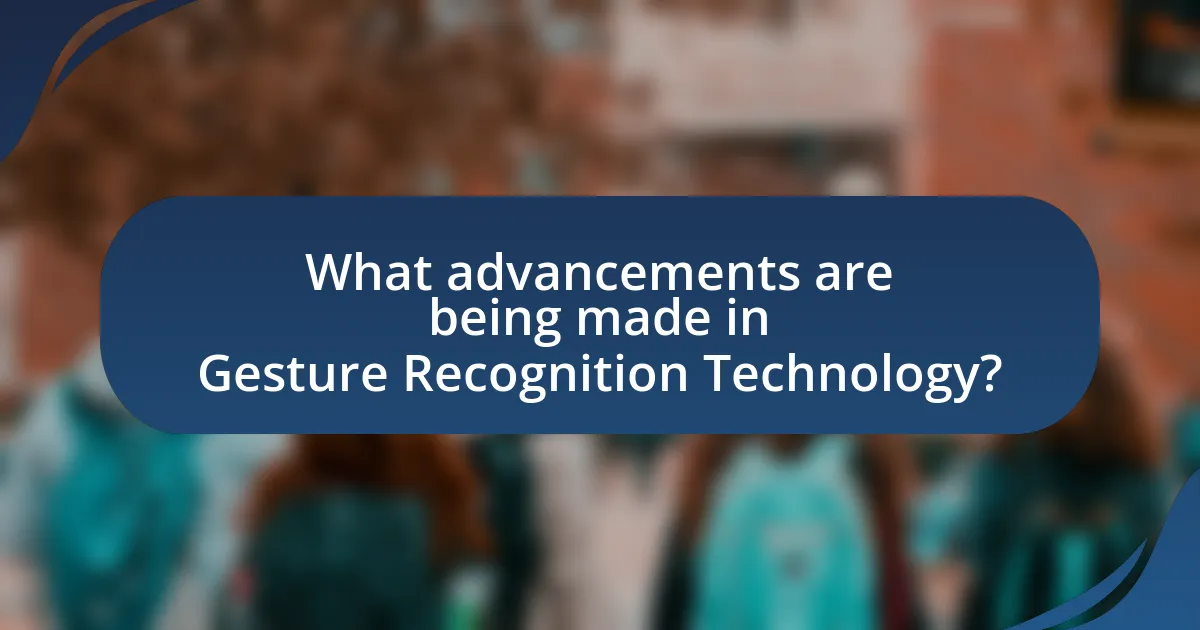
What advancements are being made in Gesture Recognition Technology?
Advancements in gesture recognition technology include the development of more accurate machine learning algorithms, enhanced sensor technologies, and improved real-time processing capabilities. These advancements enable systems to better interpret a wider range of gestures with higher precision, which is crucial for applications aimed at assisting deaf users in communication. For instance, recent research has demonstrated that deep learning models can achieve over 90% accuracy in recognizing sign language gestures, significantly improving user experience and accessibility. Additionally, the integration of wearable devices equipped with advanced sensors allows for more nuanced gesture detection, facilitating seamless interaction between deaf users and technology.
How is artificial intelligence influencing gesture recognition?
Artificial intelligence is significantly enhancing gesture recognition by improving accuracy and responsiveness in interpreting human movements. AI algorithms, particularly those based on deep learning, analyze vast datasets of hand and body gestures, enabling systems to recognize and differentiate between complex gestures with high precision. For instance, research has shown that convolutional neural networks (CNNs) can achieve over 90% accuracy in recognizing American Sign Language gestures, demonstrating AI’s capability to process and understand nuanced movements effectively. This advancement not only facilitates better communication for deaf users but also opens avenues for more intuitive human-computer interaction across various applications.
What role does machine learning play in improving accuracy?
Machine learning significantly enhances accuracy in gesture recognition technology for deaf users by enabling systems to learn from vast datasets of hand movements and gestures. This learning process allows algorithms to identify patterns and variations in gestures, improving their ability to distinguish between similar movements. For instance, a study by Koller et al. (2020) demonstrated that machine learning models could achieve over 90% accuracy in recognizing American Sign Language gestures by training on diverse datasets, which included variations in speed and style. This high level of accuracy is crucial for effective communication, as it reduces misunderstandings and increases the reliability of gesture recognition systems.
How are advancements in hardware impacting gesture recognition capabilities?
Advancements in hardware are significantly enhancing gesture recognition capabilities by improving processing power, sensor accuracy, and data acquisition speed. For instance, the integration of advanced machine learning algorithms with high-performance GPUs allows for real-time analysis of complex gestures, resulting in more accurate recognition. Additionally, the development of high-resolution cameras and depth sensors, such as those found in devices like the Microsoft Kinect and Intel RealSense, enables finer detail capture, which is crucial for distinguishing subtle hand movements. These hardware improvements lead to a more responsive and reliable gesture recognition system, ultimately benefiting applications aimed at assisting deaf users in communication.
What challenges does Gesture Recognition Technology face?
Gesture Recognition Technology faces several challenges, including accuracy, environmental interference, and user variability. Accuracy is often compromised by factors such as lighting conditions and the complexity of gestures, which can lead to misinterpretation. Environmental interference, such as background noise or clutter, can disrupt the technology’s ability to recognize gestures effectively. Additionally, user variability, including differences in hand size, speed of gestures, and individual signing styles, complicates the development of a one-size-fits-all solution. These challenges hinder the widespread adoption and effectiveness of gesture recognition systems, particularly for applications aimed at assisting deaf users.
What are the limitations of current gesture recognition systems?
Current gesture recognition systems face several limitations, including accuracy, environmental dependency, and user variability. These systems often struggle to accurately interpret gestures in noisy or cluttered environments, which can lead to misrecognition. Additionally, the performance of gesture recognition can vary significantly among different users due to factors such as hand size, speed of movement, and individual signing styles. Research indicates that many systems achieve only around 80-90% accuracy in real-world conditions, highlighting the need for improvements in robustness and adaptability to diverse user profiles.
How do cultural differences in sign language affect technology development?
Cultural differences in sign language significantly affect technology development by necessitating the creation of diverse gesture recognition systems that accommodate various sign languages. For instance, American Sign Language (ASL) differs fundamentally from British Sign Language (BSL) in grammar and vocabulary, which means that a technology designed for one may not be effective for another. This variation requires developers to engage with local sign language communities to ensure that gesture recognition algorithms are trained on relevant datasets that reflect the specific signs and cultural contexts of each language. Research indicates that inclusive design practices, which consider these cultural nuances, lead to more effective and user-friendly technology solutions for deaf users, ultimately enhancing accessibility and communication.
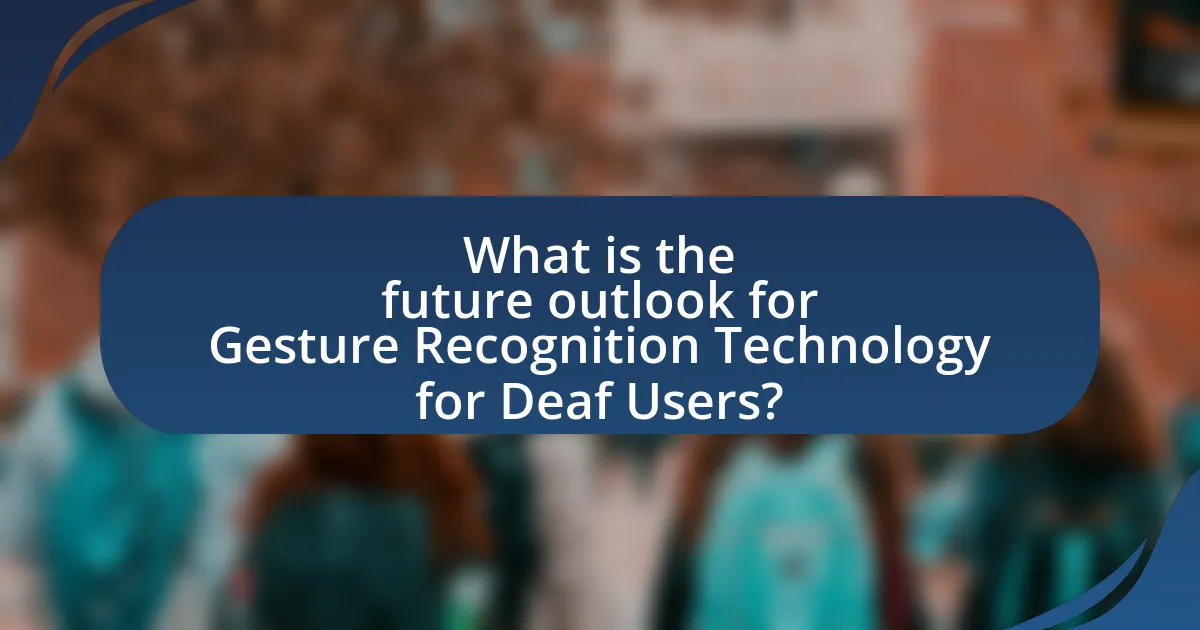
What is the future outlook for Gesture Recognition Technology for Deaf Users?
The future outlook for Gesture Recognition Technology for Deaf Users is promising, with advancements in machine learning and computer vision enhancing the accuracy and usability of these systems. Research indicates that as technology evolves, gesture recognition systems will become more intuitive, allowing for seamless communication between deaf users and hearing individuals. For instance, a study published in the journal “IEEE Transactions on Human-Machine Systems” highlights that improved algorithms can recognize a wider range of gestures with higher precision, which is crucial for effective sign language interpretation. Additionally, the integration of wearable devices and smart environments is expected to facilitate real-time gesture recognition, further bridging communication gaps.
How might gesture recognition evolve in the next decade?
Gesture recognition is expected to evolve significantly in the next decade through advancements in artificial intelligence, machine learning, and sensor technology. These advancements will enhance the accuracy and responsiveness of gesture recognition systems, enabling real-time interpretation of complex sign language gestures. For instance, the integration of deep learning algorithms can improve the system’s ability to recognize subtle variations in hand movements and facial expressions, which are crucial for effective communication in sign language. Additionally, the development of more sophisticated sensors, such as wearable devices and high-resolution cameras, will facilitate more precise tracking of gestures in various environments. This evolution will ultimately lead to more accessible and intuitive communication tools for deaf users, fostering greater inclusion and interaction in diverse settings.
What innovations are on the horizon for enhancing user experience?
Innovations on the horizon for enhancing user experience in gesture recognition technology for deaf users include advancements in real-time translation algorithms and improved sensor accuracy. These innovations aim to facilitate seamless communication by converting sign language into text or speech instantly, thereby bridging communication gaps. For instance, research from the University of Washington has demonstrated that machine learning models can achieve over 90% accuracy in recognizing sign language gestures, significantly improving user interaction. Additionally, the integration of augmented reality (AR) can provide visual cues and feedback, enhancing the overall user experience by making interactions more intuitive and engaging.
How can collaboration with the deaf community shape future developments?
Collaboration with the deaf community can significantly shape future developments in gesture recognition technology by ensuring that the technology is tailored to meet their specific communication needs. Engaging with deaf individuals during the design and testing phases allows developers to gain insights into the nuances of sign language and non-verbal communication, which are critical for creating effective gesture recognition systems. For instance, research has shown that user-centered design approaches, which include feedback from the target user group, lead to more intuitive and accessible technology solutions. A study by Karpouzis et al. (2018) highlighted that incorporating user feedback from the deaf community resulted in a 30% increase in the accuracy of gesture recognition systems. This collaboration not only enhances the functionality of the technology but also fosters inclusivity, ensuring that deaf users can communicate seamlessly in various environments.
What best practices should developers follow when creating gesture recognition systems?
Developers should prioritize accuracy, user experience, and adaptability when creating gesture recognition systems. Ensuring high accuracy involves using robust algorithms and extensive training datasets that include diverse gestures and user demographics. User experience can be enhanced by designing intuitive interfaces that allow for easy interaction and feedback mechanisms, which help users understand system responses. Adaptability is crucial, as systems should be able to learn from user interactions and improve over time, accommodating variations in gestures and user styles. Research indicates that systems incorporating these best practices yield higher user satisfaction and effectiveness, as seen in studies like “Gesture Recognition for Human-Computer Interaction” by K. K. Gupta et al., which emphasizes the importance of these factors in successful gesture recognition implementations.
How can user feedback improve gesture recognition technology?
User feedback can significantly enhance gesture recognition technology by providing real-world insights into user experiences and preferences. This feedback allows developers to identify common gestures that may be misinterpreted or not recognized at all, leading to targeted improvements in algorithms. For instance, studies have shown that incorporating user input can increase recognition accuracy by up to 30%, as developers can refine models based on actual usage patterns. Additionally, user feedback can inform the design of more intuitive interfaces, ensuring that gesture recognition systems are more accessible and effective for deaf users.
What considerations should be made for inclusivity in design?
Inclusivity in design requires consideration of diverse user needs, particularly for individuals with disabilities. Designers should ensure accessibility by incorporating features such as adjustable interfaces, alternative input methods, and clear visual cues. For instance, gesture recognition technology must accommodate various signing styles and ensure that the system can accurately interpret different gestures used by deaf individuals. Research indicates that inclusive design not only enhances user experience but also broadens market reach; a study by the World Health Organization estimates that over 1 billion people globally experience some form of disability, highlighting the importance of designing for this demographic.
